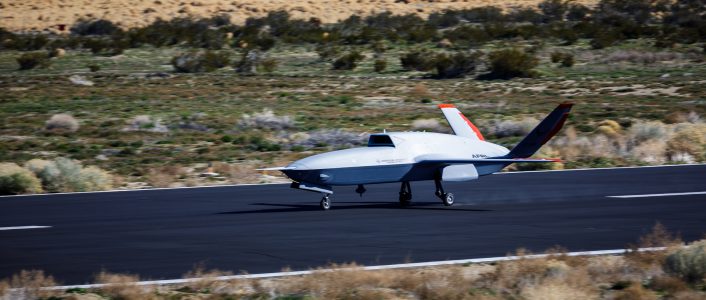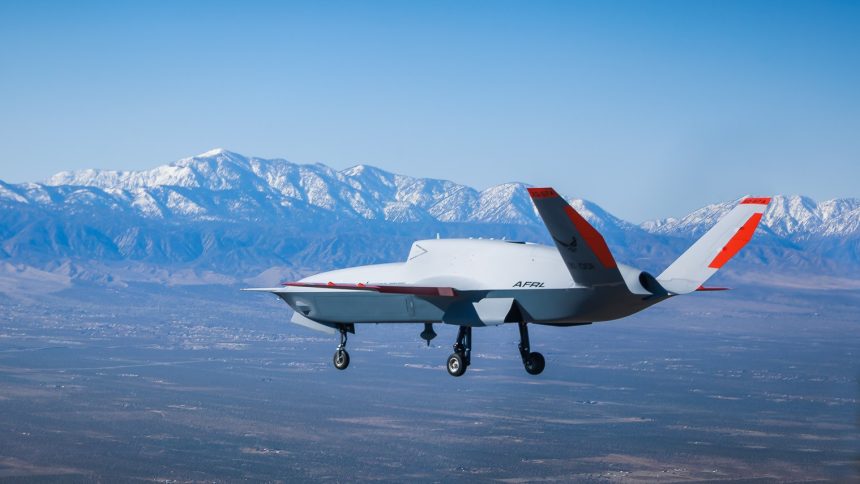AFRL announced that its new XQ-67A Off-Board Sensing Station successfully accomplished its first flight.
USAF’s Air Force Research Laboratory (AFRL) announced that on Feb. 28, 2024, its new XQ-67A accomplished its first flight. Developed by General Atomics Aeronautical Systems (GA-ASI) as part of the USAF’s Off-Board Sensing Station (OBSS) program, first images of the XQ-67A were released by GA-ASI earlier this month.
#BREAKING: First successful flight of @afresearchlab XQ-67A! The XQ-67A is the first of a second generation of @usairforce autonomous collaborative platforms. Learn more: https://t.co/iWz4zQntwk#AFResearchLab |#AFRLTech |#USAF pic.twitter.com/NHrcpGxTs0
— Air Force Research Lab – AFRL (@AFResearchLab) February 29, 2024
As the name suggests, the XQ-67A is expected to act as an attritable forward radar node, filling the USAF’s current urgent needs for such a platform. Distinguishable features on the XQ-67A is what appears to be a set of side looking radars on either side of the fuselage. With the USAF having previously expressed its desires for a distributed combination of manned and unmanned surveillance aircraft to replace the E-8 JSTARS, the XQ-67A seems to be one of the low observable unmanned aerial surveillance platforms that fit the equation.

The XQ-67A is a first of other possible low-cost drone solutions to rise in the coming years
According to AFRL the OBSS program is an evolution of the former Low Cost Attritable Aircraft Technologies (LCAAT), which previously developed the XQ-58A Valkyrie. After the LCAAT program came the Low Cost Attritable Aircraft Platform Sharing (LCAAPS) program, which transferred the technology and knowledge gained from the XQ-58A into the OBSS program. The XQ-67A is told to be the first of the second generation of such Autonomous Collaborative Platform (ACP). Doug Meador, ACP capability lead with AFRL’s Aerospace Systems Directorate said that “the XQ-67A proves the common chassis or “genus” approach to aircraft design, build and test”.
LCAAPS and OBSS program manager from AFRL’s Aerospace Systems Directorate Trenton White said that “The intention behind LCAAPS early on was these systems were to augment, not replace, manned aircraft” and that “The first generation was XQ-58, and that was really about proving the concept that you could build relevant combat capability quickly and cheaply”.
According to Trenton White, the intention from the beginning of the LCAAT program was to have multiple vehicles in development and as the vehicles became ready, they would integrate sensors, autonomy, weapons, payloads, and electronics on to the platform one by one.
As evident, both the XQ-67A and XQ-58A share the same design queues. As Doug Meador spoke, “This approach will help save time and money by leveraging standard substructures and subsystems, similar to how the automotive industry builds a product line. From there, the genus can be built upon for other aircraft — similar to that of a vehicle frame — with the possibility of adding different aircraft kits to the frame, such as an Off-Board Sensing Station or Off-Board Weapon Station, [or OBWS].” The OBWS is the next expected drone to come out of this family, testing the abilities of a missile carrying loyal wingman. Lastly, GA-ASI’s VP of Advanced Programs Michael Atwood spoke that “OBSS is the first aircraft type built and flown using a common core chassis developed by GA-ASI that promotes commonality across multiple vehicle types.”
With the XQ-67A focusing on its role as an aerial surveillance platform, it is expected that more unmanned platforms of the same family will be introduced in the coming years focusing on other roles such as weapons delivery and perhaps even electronic warfare.









